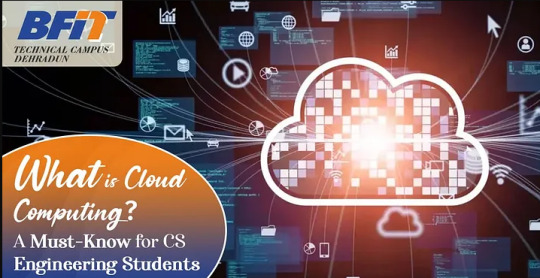#cloudcomputingintro
Explore tagged Tumblr posts
Text
What is Cloud Computing? A Must-Know for CS Engineering Students

Imagine a mystical storage device that safely preserves your toys, books, and games. With this storage system, you gain access to your belongings anywhere through the internet, even when at school or traveling away from home. The connection to your treasures becomes possible through simple access to the internet. Cloud computing functions similarly to the way our current ideas of having access to essential data operate regardless of location.
Cloud computing acts as a wonderful storage device that preserves information together with applications and services rather than toys. The internet provides you with storage space to handle data instead of traditional hard drive storage. Cloud computing enables educational institutions, businesses, and individuals to safely store and maintain important information while avoiding technical details of operation. Students majoring in computer science engineering need a thorough understanding of cloud computing since it dominates current and future technology utilization.
This blog examines cloud computing as a system while explaining its operations describing its advantages and deployment methods along with addressing its limitations together with student career options and essential competencies of this area.
What is Cloud Computing?
The fundamental principle of cloud computing depends on delivering different services through the Internet infrastructure. A cloud computing service comprises data storage with servers and databases networking capabilities and software functions as well as analytics capabilities. Cloud computing permits users to save their files not on personal computers or local servers but on remote servers maintained by cloud service providers. Internet connectivity enables you to retrieve your files and applications which reside in the cloud computing environment.
Think of it this way: Users who possess smartphones or tablets typically depend on internet connectivity to operate their online-connected applications. Cloud computing serves users through activities such as streaming music and movies, playing online games, and using educational apps. The operations happen within the cloud platform since they exchange data over the internet through servers that exist outside device storage.
Basically, Cloud computing is the use of the internet to store, retrieve, and share data. It allows users to access applications, software, and storage over the internet.
Types of Cloud Computing
The cloud computing ecosystem includes three main types or models that separate the delivery methods and usage patterns.
Infrastructure as a Service (IaaS): IaaS stands for Infrastructure as a Service which enables users to access virtual computing resources through the internet. Cloud service providers enable their users to obtain IT infrastructure components through rental agreements. This cloud computing setup lets businesses adjust their resource capabilities based on their evolving needs.
Platform as a Service (PaaS): Platform as a Service (PaaS) delivers an application development platform through which developers can build applications while skipping the responsibility of maintaining the infrastructure foundation. Software developers maintain their focus on building new applications while cloud management handles their hardware requirements.
Software as a Service (SaaS): Software as a Service (SaaS) represents the most widely used cloud computing approach that consumers use in their daily lives. Users can access software applications through the internet by using SaaS. For example, the apps and tools we use in our daily lives such as Gmail for email services, Google Docs for office applications, and Netflix for streaming.
Cloud Deployment Models
A better comprehension of cloud computing requires knowledge about its deployment models. The models describe both the creation and utilization methods of cloud service platforms. Here are the primary types:
Public Cloud: The public cloud provides services through the public internet which all organizations share. The three main cloud deployment examples include Google Cloud combined with Amazon Web Services (AWS) alongside Microsoft Azure. The model provides low costs for solutions while its storage outside of organizational systems raises security uncertainties.
Private Cloud: A private cloud system operates exclusively from a network that serves only a single organization. Organizations that choose this model receive improved security and control however the total cost increases because physical servers need to be managed by staff.
Hybrid Cloud: A hybrid cloud emerges from the combination of public and private cloud deployments to enable data and application sharing across both systems. Businesses that adopt this solution gain access to security alongside the advantage of scalability….
To Read more, Click: https://bfitgroup.in/what-is-cloud-computing/
0 notes